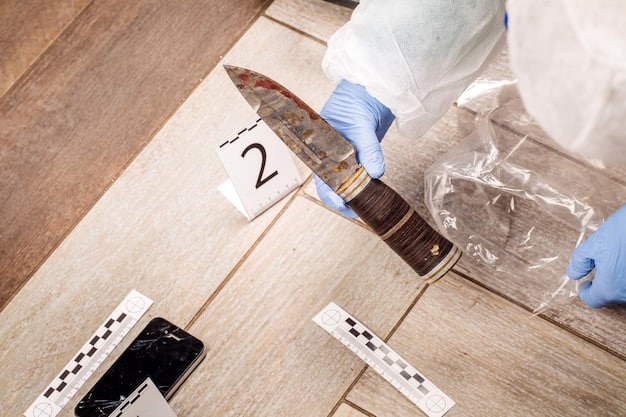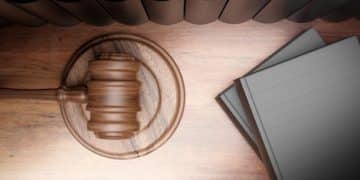Fact-Checking Forensics: Crime Scene Accuracy in Legal Dramas

Fact-checking forensics in legal dramas reveals a significant divergence from real-world crime scene investigation accuracy, often prioritizing narrative drama over scientific precision.
How accurately do legal dramas portray crime scene investigations? While shows like “Law & Order” and “CSI” captivate audiences, are their forensic depictions rooted in reality? Let’s dive into fact-checking forensics: how accurate are crime scene investigations in legal dramas?
The Glamorized World of TV Forensics
Legal dramas have long captivated audiences with their intriguing plots and brilliant detectives using cutting-edge forensics to solve crimes. But how much of what we see on screen is actually true to life? The depiction of forensic science in these shows often takes liberties with reality, prioritizing entertainment over accuracy.
The “CSI Effect”
One significant impact of these shows is the “CSI Effect,” where jurors expect more forensic evidence than is available in real-life cases. This expectation can lead to acquittals even when other forms of evidence are strong. Legal dramas often present forensic tests as quick, easy, and definitive, whereas, in reality, many tests are time-consuming, complex, and can produce ambiguous results.
These shows frequently compress timelines, showing results in hours or days that would take weeks or months in the real world. Techniques are often portrayed as infallible, ignoring the potential for human error or contamination. Writers often use complex jargon without providing proper context, potentially misleading viewers about the true nature of forensic science.

- Time Compression: Dramas condense forensic processes that take weeks into minutes.
- Infallibility: TV shows often present forensics as error-free, ignoring potential for mistakes.
- Exaggerated Technology: Advanced technology is used frequently, even in mundane cases.
In summation, while legal dramas entertain with their forensic plots, they often distort the reality of crime scene investigation, leading to unrealistic expectations and misunderstandings among viewers.
Common Misconceptions About Crime Scene Investigation
The world of crime scene investigation is often shrouded in mystery, fueled by the dramatic portrayals in popular legal dramas. Let’s unravel some common misconceptions about crime scene investigation.
The Instant DNA Test
In TV shows, DNA results are often available in minutes, revealing the perpetrator instantly. In reality, DNA analysis is a meticulous process that can take days or even weeks to complete. Besides collecting samples, it involves careful extraction, amplification, and analysis, any of which can introduce delays.
Many shows portray DNA as a foolproof method, ignoring the potential for contamination or degradation of samples. Also, shows often omit the fact that DNA databases are not comprehensive, and a match depends on whether the suspect’s DNA is already in the system.
- Speed of Analysis: Real DNA tests take days, not minutes, as shown on TV.
- Sample Integrity: Contamination can occur and degrade samples.
- Database Limitations: DNA databases aren’t comprehensive; a match isn’t guaranteed.
Therefore, the rapid and infallible DNA tests seen in legal dramas are a far cry from the actual complexities and limitations of forensic DNA analysis.
The Real Skills of Crime Scene Investigators
Beyond the high-tech gadgets and dramatic revelations seen on TV, the real skills of crime scene investigators involve a mix of science, meticulous observation, and critical thinking. Accuracy, attention to detail, and a systematic approach are crucial in gathering and preserving evidence.

Observation and Documentation
Investigators must be detail-oriented, noticing subtle clues that might be overlooked. They need to document everything meticulously, from photographs and sketches to detailed written notes. This process ensures that the scene is accurately preserved for later analysis and court presentation.
Investigators must have a strong understanding of forensic science principles. They need to know how to collect evidence without contaminating it, how to properly package and label items, and how to maintain the chain of custody. Knowledge of criminal law and procedure is also essential to ensure that evidence is admissible in court.
- Meticulous Observation: Noticing subtle details is crucial for uncovering hidden clues.
- Scientific Knowledge: Understanding forensic principles ensures proper evidence handling.
- Legal Awareness: Investigators must adhere to legal procedures for evidence admissibility.
Thus, the true skills of crime scene investigators rely on a combination of scientific knowledge, meticulous observation, and adherence to legal procedures, far removed from the glamorized portrayals in legal dramas.
Ethical Considerations in Forensic Science
Ethical considerations are paramount in forensic science, where the integrity of evidence and the objectivity of analysis can directly impact justice. Legal dramas often overlook these crucial aspects, focusing instead on sensational plot twists and dramatic reveals.
Avoiding Bias
Forensic scientists must be free from bias, whether conscious or unconscious. They need to analyze evidence objectively, without letting personal beliefs or assumptions influence their findings. Cognitive bias, confirmation bias, and contextual bias can all affect the outcome of forensic analysis.
Maintaining the chain of custody is essential to ensure the integrity of evidence. Every person who handles the evidence must be documented, and any gaps or inconsistencies in the chain can raise doubts about the evidence’s reliability. Proper documentation, storage, and handling are critical to prevent contamination or tampering.
Honesty, objectivity, and accuracy are the bedrock of forensic science ethics. Keeping the forensic science honest allows the system to work more effectively for fair legal outcomes.
- Objectivity: Forensic scientists must be free from personal biases that might influence their views.
- Chain of Custody: Maintaining unbroken documentation logs.
- Transparency: Forensic investigations require the highest of transparency.
Thus, forensic science ethics center around guarding facts, staying unbiased, and clearly documenting processes, ensuring fairness in legal outcomes, which is often blurred in TV depictions.
The Impact of Legal Dramas on Public Perception
Legal dramas have a significant impact on how the public perceives the criminal justice system. These shows often shape beliefs about evidence, police work, and the legal process. This can have real-world implications, affecting jury decisions and public policy.
The “CSI Effect” leads jurors to expect more forensic evidence than is available, raising the burden of proof. Jurors may give undue weight to forensic evidence, even when it is not conclusive. The misconstrued perception of DNA is also significant.
- Unrealistic Expectations: Jurors overestimate the availability and reliability.
- Over Reliance: Juries can give greater weight to the flawed or incomplete forensic evidence.
- Public Policy: Misunderstandings can occur and affect community views of law enforcement.
In short, media dramatics can often sway the public from factual integrity.
Improving Accuracy in Legal Dramas
While entertainment is the priority, legal dramas can strive for greater accuracy in their portrayal of forensic science. This would not only educate the public but also enhance the credibility and impact of these shows. In fact, by embracing a commitment to precision, legal shows can become more authentic.
Consultants can play a valuable role in ensuring accuracy. They can review scripts, advise on forensic procedures, and debunk common myths about crime scene investigation. By involving experts in the writing and production process, shows can avoid perpetuating misinformation.
Writers should also be aware of the ethical considerations involved in forensic science. They can explore issues such as bias, evidence tampering, and the potential for error in forensic analysis. By addressing these issues, dramas can promote a more nuanced understanding of the challenges faced by forensic professionals.
Ultimately, striving for accuracy enhances the credibility of legal dramas. When TV shows are honest in their depictions, the public becomes better prepared to be knowledgeable citizens.
- Forensic Consultants: Professionals can verify the material is accurate and truthful.
- Awareness: Ethical quandaries and topics can improve the authenticity.
- Honesty: When authenticity is added to dramatic material, public perception can also greatly improve.
| Key Point | Brief Description |
|---|---|
| 🔎 TV Forensics | Often oversimplified and accelerated for drama. |
| 🔬 Real Forensics | Time-consuming, meticulous, and prone to errors. |
| ⚖️ Ethical Concerns | Bias and chain of custody are often ignored. |
| 🎬 Public Perception | Legal shows shape beliefs on forensics. |
Frequently Asked Questions
▼
Jurors expect more forensic evidence due to TV portrayals, potentially leading to acquittals in cases with strong non-forensic evidence. They may overestimate the reliability and speed of forensic tests, raising the burden of proof.
▼
Bias, improper handling of evidence, and failing to completely maintain the chain of custody can undermine the fact finding process as well as taint possible convictions.
▼
By inviting forensic experts to visit the production and consult on set. They can aid and advise to debunk common forensic myths and properly vet information and procedures.
▼
Essential for ensuring credibility, and so that evidence is factual and accurate. This prevents doubts on reliability, contamination, loss, or tampering of the evidence.
▼
With the advent of scientific evidence, the legal system can more fairly and credibly take place provided that there are qualified and honest participants available. This means less biased judgment to accurately protect human rights.
Conclusion
While legal dramas offer intriguing entertainment, they often stray far from the realities of forensic science. Understanding these discrepancies prepares the public for a deeper appreciation of the facts while helping to discern between fact and fiction.





